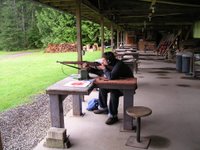Guns

I like guns. When I was an undergraduate at UVA I joined the Army ROTC for a semester as a civilian. I never had to wear camo except as protection during maneuvers, but I still had to submit my dental records. I had to demonstrate proficiency in setting and detonating a Claymore Mine (no live ordinance) and firing anti-tank artillery. The real stuff included shooting, disassembling, and cleaning an M-16; throwing hand grenades from different levels of cover in a timed assault course; and "combat water survival training." The water training involved being blindfolded, covered with equipment, given a rubber M-16 and being pushed off the high dive. We also had to make flotation devices out of our camo pants and swim across the pool with our rubber M-16 in the air.
Since ROTC I shot skeet once and recently fired a fully automatic AK-47. I was a pretty good shot with the skeet. Feeling all of the bullets pour out of the AK-47 was an amazing sensation.
My first date with Dan was lunch at an Ethiopian place. I suspect in retrospect that the food was really quite good, but I was too nervous to eat. He mentioned that he was going to shoot at the range in Richmond that weekend. My immediate response was "cool, when can you take me too?" He seemed surprised, I guess vegetarian yoginis are not usually to into firearms.
This past Saturday we went to the range. I shot his .40 caliber pistol and semi-automatic MP-5. For me the main challenge of the MP-5 is to have the arm strength to hold it up in the air for any amount of time. I was much more drawn to the pistol. It was light and easy to hold, but much more challenging to fire. I had to get used to the kick and not try to overcompensate by shooting down.
Dan told me that when I fired the pistol I had a look of sheer glee on my face. I don't doubt this. When I nailed the target directly in the head, and I was in fact aiming for the head, I felt like a kid who got just what she wanted from Santa.










